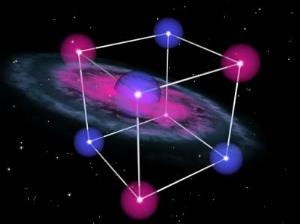
Electrons are negatively charged elementary particles. They form the shells around atoms and ions. This or something similar is what you will find in text books. Soon, however, this information may have to be supplemented. The reason is that many physicists believe that electrons have a permanent electric dipole moment. An electric dipole moment is usually created when positive and negative charges are spatially separated. Similar to the north and south poles of a magnet, there are two electric poles. In the case of electrons, the situation is much more complicated because electrons should not actually have any spatial dimension. Despite this, an entire range of physical theories that go beyond the standard model of elementary particle physics are based upon the existence of dipole moment. These theories in turn would explain how the universe in the form that we know it could have been created in the first place. According to prevailing theories, the big bang some 13.7 billion years ago would have had to have created just as much matter as antimatter. Since both obliterate each other, nothing would have remained. In reality, however, more matter than antimatter was actually created. An electric dipole moment of the electron could explain this imbalance.
Up to now, nobody has successfully proven the existence of this assumed tiny dipole moment. Existing methods are simply not sensitive enough. A small piece of ceramic is set to change this soon. Dr. Marjana Ležaic and Dr. Konstantin Rushchanskii from the Institute of Solid State Physics at Forschungszentrum Jülich and Professor Nicola Spaldin from the University of California in Santa Barbara designed this ceramic, which has very special properties, in a virtual laboratory using the Jülich supercomputer JUROPA. The new europium barium titanate should enable measurements to be 10 times more sensitive than they were in the past. According to the Jülich physicists, "this could be sufficient to find the electric dipole moment of the electron".
As electric moment cannot be directly measured, the physicists are working together with scientists from the American Yale University as well as with Czech research institutions in Prague in order to indirectly prove its existence. The researchers in Yale have developed an experimental setup that uses an extremely sensitive SQUID magnetometer to measure the magnetization of the piece of ceramic in an electric field. Their aim is to demonstrate a change in the magnetization when the electric field is reversed. This would simultaneously be the sought-after evidence that the electric dipole moment exists. In an electron, an electric dipole can only ever be oriented parallel or anti-parallel to the electron spin. In an electric field, most of the electrons are oriented so that their dipole moment is parallel to the field. Fewer are oriented in the other direction. This should lead to a measurable magnetization. If the electric field is reversed, the dipole moments of the electrons are reversed leading consequently to a simultaneous, measurable change in the magnetization. Without an electric dipole moment, on the other hand, the magnetization would remain unchanged.
"It would have been very difficult to find such a well-suited material by trial and error," said Ležaic. This material must have an unusual combination of properties: a high concentration of magnetic ions, magnetic disorder at temperatures below four degrees Kelvin and a reversible electric polarization. "Our colleagues in Yale who came up with the idea of the measurements and conducted them had already tested different materials. However, a new material with all of the necessary properties can be found faster with the use of theoretical analysis and computer simulations." Ležaic, as the head of the young investigators group, her group member Rushchanskii, and her cooperation partner Spaldin virtually synthesized and analysed europium barium titanate on the supercomputer in Jülich. To do so, all they needed was its chemical composition and the basic equations of quantum mechanics. From these, they calculated the interaction between individual atoms and electrons and the local magnetic properties. So it was that they found the optimum ceramic.
Team colleagues in Prague have already synthesized and characterized the material in the laboratory and confirmed the properties calculated in Jülich. Only the sought-after dipole moment of the electron remains undiscovered. "Unwanted effects are still inhibiting the measurements," said a disappointed Ležaic. "But we're working intensively on improving the material even further."
Further Information:
K. Z. Rushchanskii, S. Kamba,V. Goian, P. Vanek, M. Savinov, J. Prokleška, D. Nuzhnyy, K. Knížek, F. Laufek, S. Eckel, S. K. Lamoreaux, A. O. Sushkov, M. Ležaic, N. A. Spaldin:
A multiferroic material to search for the permanent eletric dipole moment of the electron.
In: Nature Materials; published online 18 July 2010, DOI 10.1038/nmat2799
Source: Helmholtz Association of German Research Centres
Last update: 28.07.2010
Perma link: https://www.internetchemistry.com/news/2010/jul10/electron-dipole-moment.php
More chemistry: index | chemicals | lab equipment | job vacancies | sitemap
Internetchemistry: home | about | contact | imprint | privacy
© 1996 - 2023 Internetchemistry
